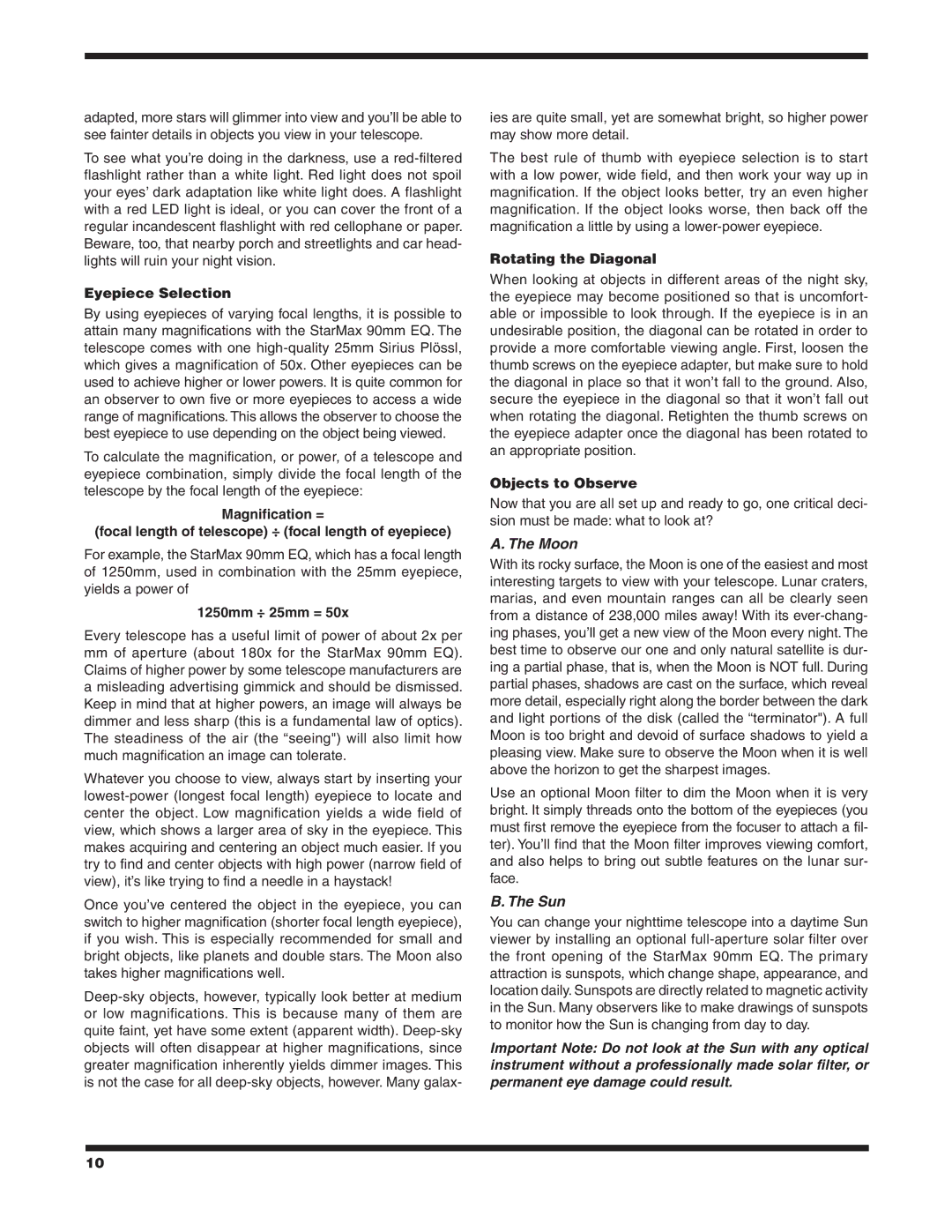
adapted, more stars will glimmer into view and you’ll be able to see fainter details in objects you view in your telescope.
To see what you’re doing in the darkness, use a
Eyepiece Selection
By using eyepieces of varying focal lengths, it is possible to attain many magnifications with the StarMax 90mm EQ. The telescope comes with one
To calculate the magnification, or power, of a telescope and eyepiece combination, simply divide the focal length of the telescope by the focal length of the eyepiece:
Magnification =
(focal length of telescope) ÷ (focal length of eyepiece)
For example, the StarMax 90mm EQ, which has a focal length of 1250mm, used in combination with the 25mm eyepiece, yields a power of
1250mm ÷ 25mm = 50x
Every telescope has a useful limit of power of about 2x per
mmof aperture (about 180x for the StarMax 90mm EQ). Claims of higher power by some telescope manufacturers are a misleading advertising gimmick and should be dismissed. Keep in mind that at higher powers, an image will always be dimmer and less sharp (this is a fundamental law of optics). The steadiness of the air (the “seeing") will also limit how much magnification an image can tolerate.
Whatever you choose to view, always start by inserting your
Once you’ve centered the object in the eyepiece, you can switch to higher magnification (shorter focal length eyepiece), if you wish. This is especially recommended for small and bright objects, like planets and double stars. The Moon also takes higher magnifications well.
ies are quite small, yet are somewhat bright, so higher power may show more detail.
The best rule of thumb with eyepiece selection is to start with a low power, wide field, and then work your way up in magnification. If the object looks better, try an even higher magnification. If the object looks worse, then back off the magnification a little by using a
Rotating the Diagonal
When looking at objects in different areas of the night sky, the eyepiece may become positioned so that is uncomfort‑ able or impossible to look through. If the eyepiece is in an undesirable position, the diagonal can be rotated in order to provide a more comfortable viewing angle. First, loosen the thumb screws on the eyepiece adapter, but make sure to hold the diagonal in place so that it won’t fall to the ground. Also, secure the eyepiece in the diagonal so that it won’t fall out when rotating the diagonal. Retighten the thumb screws on the eyepiece adapter once the diagonal has been rotated to an appropriate position.
Objects to Observe
Now that you are all set up and ready to go, one critical deci‑ sion must be made: what to look at?
A. The Moon
With its rocky surface, the Moon is one of the easiest and most interesting targets to view with your telescope. Lunar craters, marias, and even mountain ranges can all be clearly seen from a distance of 238,000 miles away! With its
Use an optional Moon filter to dim the Moon when it is very bright. It simply threads onto the bottom of the eyepieces (you must first remove the eyepiece from the focuser to attach a fil‑ ter). You’ll find that the Moon filter improves viewing comfort, and also helps to bring out subtle features on the lunar sur‑ face.
B. The Sun
You can change your nighttime telescope into a daytime Sun viewer by installing an optional
Important Note: Do not look at the Sun with any optical instrument without a professionally made solar filter, or permanent eye damage could result.
10
